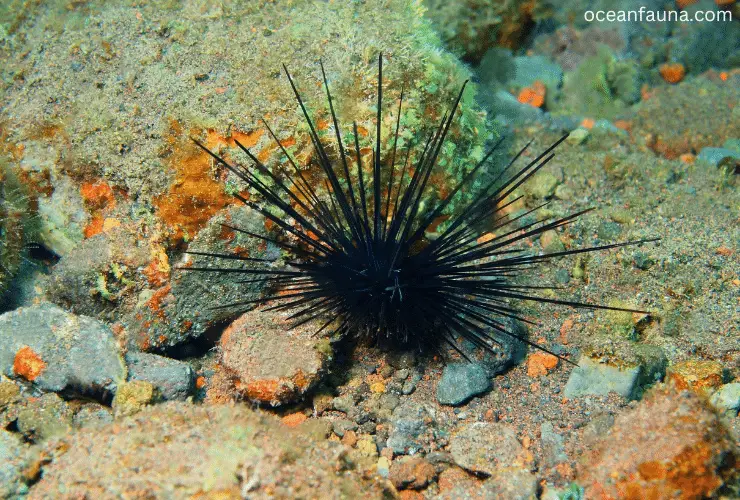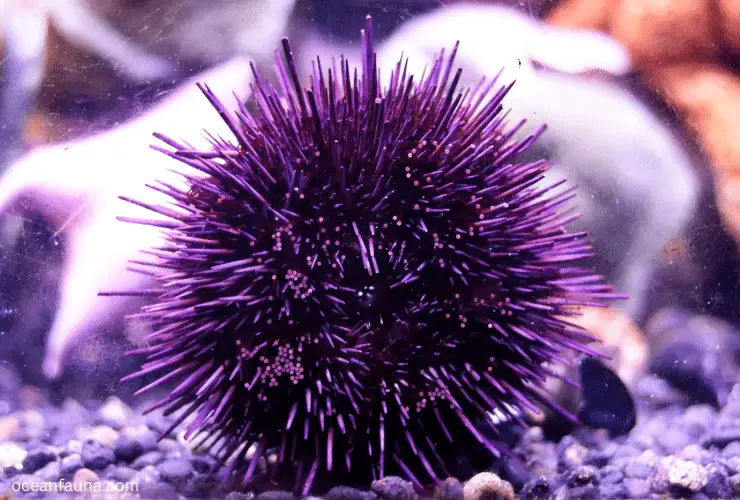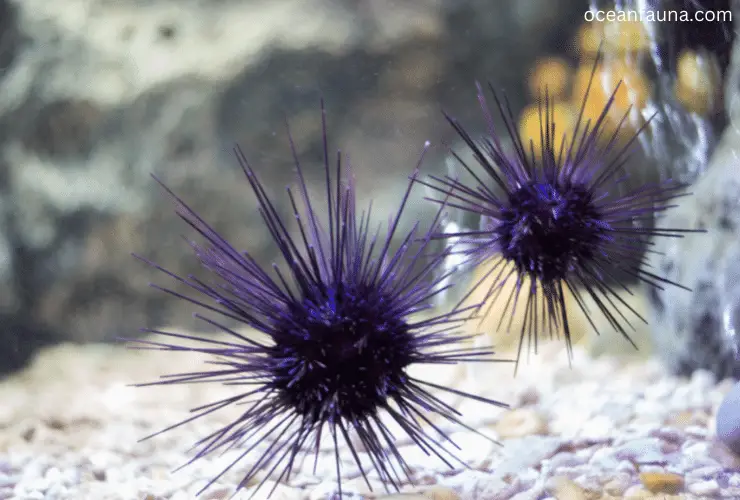Sea urchins release clouds of eggs and sperm into the seawater when they reproduce. Although millions of larvae develop, only a small percentage eventually return to the coast, where they can mature into adults. It could be seen as a daring plan for one’s future. However, it is effective in seawater.
In the reproduction process known as “broadcast spawning,” a female sea urchin disperses her eggs into the surrounding water. Around the same time, the males will discharge their sperm, and the eggs will be fertilized out in the open ocean. Isn’t it quite interesting?
We have decided to dive deep into the process of sea urchin spawning and find out more about this brilliant action. How does it all work? Where do the newborn larvae go? What’s the secret of urchin growth? And how do they reproduce? Let’s get started and unwrap these mysterious queries!
What Type of Reproduction Is Sea Urchin?
According to the study given in the Encyclopedia of Reproduction (second edition, 2018) of Science Direct, “The sea urchin is a powerhouse in terms of gamete production. It is not difficult to coax sea urchins, either male or female, into releasing large amounts of eggs or sperm.” (source)

The sea urchin larvae develop by twisting themselves around like a sock and growing from the inside out. Adults reproduce by exuding clouds of eggs and sperm, which later combine to form extremely small larvae. So, what happens next with the micro larvae?
The larvae swim through the water until they locate a safe place to land, at which point their tube feet stretch out from the interior of their bodies to flip them over. This appears to be the awkward and magnificent transition that sea urchins undergo during their transformation.
According to wide research on NCBI, “this type of reproduction is known as regeneration and that’s the reason they are inferred as regenerative animals.” (Source)
How Do Sea Urchins Reproduce Sexually or Asexually? (Sea Urchin Reproduction Cycle)
Dioecious denotes that urchins have distinct male and female populations. They release gametes into the water at the same time in a process called synchronous broadcast spawning, which is facilitated by the cooperation of males and females.
There are multiple distinct larval stages after fertilization. However, the duration of these phases varies greatly between species. The result is always the same, though: tiny male and female baby urchins. In the context of sexual reproduction, this is the fertilization process.
Now come to the second section: how do sea urchins reproduce asexually? The simple answer is they cannot reproduce asexually. But they do reproduce as a result of sexual reproduction. We will discuss it further in detail below.
Do Sea Urchins Reproduce Internally or Externally?
Sea urchins reproduce externally. They do not practice internal fertilization. The males do this by dispersing their sperm in water, which signals the female to release millions of tiny, jelly-coated eggs.
They are one of the most widely spread and abundant marine creatures that reproduce externally.
How Fast Do Sea Urchins Reproduce?
About two months are needed for the Sea Urchin to develop inside its egg. Their complete maturity isn’t reached for another 3–5 years. Yet, with such a long lifespan also comes a protracted reproductive period.
Most sea urchins have a two-year breeding cycle, and this is true even for the most well-studied species. This is a major setback for studies involving gene knockout, insertion, or editing, which rely on rapid progeny production.
Also See: Are Sea Urchins Invasive?
How Often Do Sea Urchins Reproduce?
According to the “Alaska Department of Fish and Game”, “Southeast Alaska has its breeding season between March and September. During spawning, urchins congregate and engage in broadcast spawning, a reproductive strategy that relies on external fertilization. Female urchins can release anywhere from 100,000 to 2,000,000 fertilized eggs into the ocean.”
So, from the above-mentioned fact given by ADF&G, it is clear that sea urchins reproduce several times each year. The spawning season starts with gonad vesiculation and typically lasts from March to September. These eggs have a high chance of surviving the harsh and turbulent ocean environment to make it to the seafloor to grow. (Source)
How Do Purple Sea Urchins Reproduce?
Sexual maturity in purple sea urchins occurs between two and three. They don’t try to impress or otherwise stand out to their partner. They instead spawn or sexually reproduce by releasing eggs and sperm into the water, just like other sea urchins.

Specifically, sea urchins rely on luck when it comes to having offspring. They do not choose a partner but instead release their gametes into the environment, hoping they will inevitably recombine and produce offspring. Fecundation occurs in only about 10% to 40% of eggs.
How Do Green Sea Urchins Reproduce?
Green sea urchins are not much different from other kinds of sea urchins. Male and female green sea urchins exist. They reproduce by releasing gametes into the water, and many eggs are fertilized during the springtime mass spawning.
Echinopluteus eggs hatch into bilaterally symmetrical larvae that resemble upside-down jellyfish. They leave the plankton when they’re very young and go through a metamorphosis to become a tiny urchin, only a few millimeters in diameter, that lives under rocks or other covers to evade predators.
Also See: Are Sea Urchins Decomposers?
How Do Sea Urchins Grow and Develop?
The growth and development life cycle of a sea urchin is very complicated. Research from frontiersin.org indicates that “insemination is accomplished using in vitro fertilization, with male and female sea urchins fertilizing and ovulating into the water, respectively.
About 9 hours after gametes are fertilized, sea urchins hatch into blastulas, which then develop into gastrulas at 16 hours, prisms at 22 hours, 2-arm pluteus at 34 hours, and 4-arm pluteus at 48 hours. These are the foremost stages of development.” (Source)
Covering behavior is shown by all species of sea urchins for better growth, whether found in the intertidal zone, the shallow sea, or the deep sea and may involve spines and tube feet to manipulate objects in the environment onto their bare body surfaces.
Now, six ideas have been offered to explain this growth behavior in sea urchins.
- security against unforeseen dangers,
- almost reflexive actions,
- the avoidance of thirst,
- extra feeding habits,
- safeguarding against waterborne debris and crashing waves, and
- should stay away from excessive light.
How Long Do Sea Urchins Take to Grow?
It takes less than two months for fluffy pincushions like sea urchins to look like mature sea urchins. But they need to be more mature at this stage.
Depending on the species, young sea urchins can take anywhere from two to six years to attain sexual maturity. They must avoid being eaten by starfish and sea otters during this time.
FAQ:
Do sea urchins lay eggs? Do all sea urchins lay eggs?
Yes, sea urchins lay eggs, but all sea urchins do not lay eggs. Only female sea urchins lay eggs in the seawater. This is a female sea urchin’s primary mode of reproduction.
How many eggs does a sea urchin lay?
A female sea urchin lays 100,000 to 2,000,000 eggs in the seawater for the external fertilization process. Thus, millions of eggs are released into the ocean every year and only a few survive for long enough to hatch. Only about 10% of those hatchlings develop into fully grown adults.
Do sea urchins have gender?
Yes, sea urchins have separate genders – male and female. Sea urchins also have a solitary life cycle and are born as solitary eggs. They become social and mate with sperm in the water for further fertilization.
How do sea urchins multiply?
Sea urchins multiply by sending millions of eggs and sperms into the water and then millions of larvae are formed after external fertilization. Only 10% to 40% survive, from which only 1% to 7% reach maturity level.
For long-lived species like sea urchins, there will be only a few sea urchins in the world and their populations grow or decline based on their reproduction rate.
How many babies does an urchin have?
An urchin could have hundreds or thousands of babies as they reproduce millions of eggs from which 10-40 percent survive to become mature adults. This shows an urchin could give birth to thousands of baby sea urchins if the survival percentage is high.
Conclusion
Sea urchins have a rich and fascinating life history. Sea urchins’ reproductive cycle (external fertilization) is very interesting and incredible.
Their growth rate is highly dependent on their reproductive, hatching, and survival rates. Each year, sea urchins can produce millions of eggs and over 1% of those hatchlings are mature individuals.
Hope you learned something new about sea urchins’ reproductory cycle. If you have any questions or comments, please contact us!
Cheers!


3 thoughts on “How Do Sea Urchins Reproduce? [Explained]”